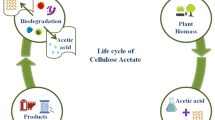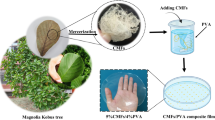Abstract
Plastic film is widely produced and applied in many daily applications. Although it provides many benefits to human activity, the disposal of commercial plastics has always been a serious problem as it will contribute to landfilling issues and environmental pollution. Bioplastic film was invented to resolve part of this issue, as most of the plastic film produced from natural sources is biodegradable. However, the biodegradability and characteristics of the film are highly dependent on the type of raw material, production procedure, and chemical composition. In this study, extracted kapok cellulose was acetylated into cellulose acetate (CA) with various levels of acetic acid (17.5, 20, and 22.5 mL), acetic anhydride (5, 7.5, and 10 mL) and acetylation time (30, 45 and 60 min). The Box–Behnken design was applied to evaluate the quality of the produced film. The design showed that the level of acetic acid has a strong impact on CA’s yield, acetic anhydride has a greater influence on tensile strength, and CA’s solubility has a stronger connection with the acetylation time. All modeling equations developed were validated with the coefficient of determination, R2 more than 0.6. The optimized factor levels for the ductile-like film on acetic acid, acetic anhydride, and acetylation time are 20.530 mL, 9.546 mL, and 55.45 min, respectively. Whereas for brittle-like film, the optimized factor level is 22.399 mL, 10 mL, and 60 min, respectively. The ductility and brittleness of a plastic film can be modified by adjusting these level factors.


Similar content being viewed by others
References
Boonniteewanich J, Pitivut S, Tongjoy S, Lapnonkawow S, Suttiruengwong S (2014) Evaluation of carbon footprint of bioplastic straw compared to petroleum based straw products. Energy Procedia 56:518–524. https://doi.org/10.1016/j.egypro.2014.07.187
Mekonnen T, Mussone P, Khalil H, Bressler D (2013) Progress in bio-based plastics and plasticizing modifications. J Mater Chem A 1(43):13379–13398
Alshehrei F (2017) Biodegradation of synthetic and natural plastic by microorganisms. J Appl Environ Microbiol 5(1):8–19
Atiwesh G, Mikhael A, Parrish CC, Banoub J, Le TAT (2021) Environmental impact of bioplastic use: a review. Heliyon 7(9):07918. https://doi.org/10.1016/j.heliyon.2021.e07918
Al-Khairy D, Fu W, Alzahmi AS, Twizere JC, Amin SA, Salehi-Ashtiani K, Mystikou A (2022) Closing the gap between bio-based and petroleum-based plastic through bioengineering. Microorganisms 10(12):2320. https://doi.org/10.3390/microorganisms10122320
Coppola G, Gaudio MT, Lopresto CG, Calabro V, Curcio S, Chakraborty S (2021) Bioplastic from renewable biomass: a facile solution for a greener environment. Earth Syst Environ 5:231–251. https://doi.org/10.1007/s41748-021-00208-7
Shah TV, Vasava DV (2019) A glimpse of biodegradable polymers and their biomedical applications. e-Polymers 19(1):385–410. https://doi.org/10.1515/epoly-2019-0041
Abotbina W, Sapuan SM, Sultan MTH, Alkbir MFM, Ilyas RA (2021) Development and characterization of cornstarch-based bioplastics packaging film using a combination of different plasticizers. Polymers 13(20):3487. https://doi.org/10.3390/polym13203487
Sultan NFK, Johari WLW (2017) The development of banana peel/corn starch bioplastic film: a preliminary study. Bioremediat Sci Technol Res 5(1):12–17. https://doi.org/10.54987/bstr.v5i1.352
Vijayalaksmi M, Govindaraj V, Anisha M, Vigneshwari N, Gokul M, Nithila EE, Bebin M, Prasath TA, Chezhiyan P (2022) Synthesis and characterization of banana peel starch-based bioplastic for intravenous tubes preparation. Mater Today Commun 33:104464. https://doi.org/10.1016/j.mtcomm.2022.104464
Cifriadi A, Panji T, Wibowo NA, Syamsu K (2017) Bioplastic production from cellulose of oil palm empty fruit bunch. IOP Conf Ser 65(1):012011. https://doi.org/10.1088/1755-1315/65/1/012011/meta
Yang J, Ching YC, Chuah CH, Liou NS (2020) Preparation and characterization of starch/empty fruit bunch-based bioplastic composites reinforced with epoxidized oils. Polymers 13(1):94. https://doi.org/10.3390/polym13010094
Rajendran N, Puppala S, Sneha Raj M, Ruth Angeeleena B, Rajam C (2012) Seaweeds can be a new source for bioplastics. J Pharm Res 5(3):1476–1479
Pacheco D, Cotas J, Marques JC, Pereira L, Gonçalves AM (2022) Seaweed-based polymers from sustainable aquaculture to “greener” plastic products. In: Sustainable global resources of seaweeds bioresources, cultivation, trade and multifarious applications, vol 1, pp 591–602. https://doi.org/10.1007/978-3-030-91955-9_31
Tokiwa Y, Calabia BP, Ugwu CU, Aiba S (2009) Biodegradability of plastics. Int J Mol Sci 10(9):3722–3742. https://doi.org/10.3390/ijms10093722
Poon JJ, Tan MC, Kiew PL (2020) Ultrasound-assisted extraction in delignification process to obtain high purity cellulose. Cellulose Chem Technol 54(78):725–734. https://doi.org/10.35812/CelluloseChemTechnol.2020.54.72
Shah M, Rajhans S, Pandya HA, Mankad AU (2021) Bioplastic for future: a review then and now. World J Adv Res Rev 9(2):56–67. https://doi.org/10.30574/wjarr.2021.9.2.0054
Arfin T (2020) Cellulose and hydrogel matrices for environmental applications. In: Sustainable nanocellulose and nanohydrogels from natural sources. Elsevier, Amsterdam, pp 255–274. https://doi.org/10.1016/B978-0-12-816789-2.00012-2
Arruebo M, Sebastian V (2020) Batch and microfluidic reactors in the synthesis of enteric drug carriers. In: Nanotechnology for oral drug delivery. Academic Press, New York, pp 317–357. https://doi.org/10.1016/B978-0-12-818038-9.00008-9
Lalan MS, Patel VN, Misra A (2021) Polymers in vaginal drug delivery: recent advancements. In: Applications of polymers in drug delivery. Elsevier, Amsterdam, pp 281–303. https://doi.org/10.1016/B978-0-12-819659-5.00010-0
Shah S, Matkawala F, Garg S, Nighojkar S, Nighojkar A, Kumar A (2020) Emerging trend of bio-plastics and its impact on society. Biotechnol J Int 24(4):1–10. https://doi.org/10.9734/bji/2020/v24i430107
Riaz QUA, Masud T (2013) Recent trends and applications of encapsulating materials for probiotic stability. Crit Rev Food Sci Nutr 53(3):231–244. https://doi.org/10.1080/10408398.2010.524953
Arjun N, Narendar D, Sunitha K, Harika K, Nagaraj B (2016) Development, evaluation, and influence of formulation and process variables on in vitro performance of oral elementary osmotic device of atenolol. Int J Pharm Investig 6(4):238. https://doi.org/10.4103/2230-973x.195951
Ahmad A, Waheed S, Khan SM, Shafiq M, Farooq M, Sanaullah K, Jamil T (2015) Effect of silica on the properties of cellulose acetate/polyethylene glycol membranes for reverse osmosis. Desalination 355:1–10. https://doi.org/10.1016/j.desal.2014.10.004
Majid RA, Mohamad Z, Rusman R, Zulkornain AA, Halim NA, Abdullah M, Low JH (2018) Development of tea waste/kapok fiber composite paper. Chem Eng Trans 63:457–462
Zhang H, Zhang G, Zhu H, Wang F, Xu G, Shen H, Wang J (2021) Multiscale kapok/cellulose aerogels for oil absorption: the study on structure and oil absorption properties. Ind Crops Prod 171:113902. https://doi.org/10.1016/j.indcrop.2021.113902
Putri RW, Rendana M, Waluyo U, Andrianto T (2022) Effect of plasticizer and concentration on characteristics of bioplastic based on cellulose acetate from Kapok (Ceiba pentandra) fiber. Sci Technol Indonesia 7(1):73–83. https://doi.org/10.26554/sti.2022.7.1.73-83
Zheng Y, Wang J, Zhu Y, Wang A (2015) Research and application of kapok fiber as an absorbing material: a mini review. J Environ Sci 27:21–32. https://doi.org/10.1016/j.jes.2014.09.026
Naharudin AU, Shaarani SHN, Rou LM, Hamidi NH, Ahmad N, Rasid R (2019) Kapok as an adsorbent for industrial wastewater. J Chem Eng Ind Biotechnol 5(2):48–54. https://doi.org/10.15282/jceib.v5i2.3727
Yunos N, Müller J, Chen SK, Tan KB, Hepp M, Butz B, Schulte A, Wesner D, Schönherr H, Talib ZA, Salim NSM (2022) Superoleophilic-hydrophobic Kapok oil sorbents via energy efficient carbonization. J Nat Fibers 19(15):12398–12414. https://doi.org/10.1080/15440478.2022.2060403
Tye YY, Lee KT, Abdullah WNW, Leh CP (2012) Potential of Ceiba pentandra (L.) Gaertn. (kapok fiber) as a resource for second generation bioethanol: effect of various simple pretreatment methods on sugar production. Bioresour Technol 116:536–539. https://doi.org/10.1016/j.biortech.2012.04.025
Syed Draman SF, Daik R, Abdul Latif F, El-Sheikh SM (2014) Characterization and thermal decomposition kinetics of Kapok (Ceiba pentandra L.)—based cellulose. BioResources 9(1):8–23. https://doi.org/10.15376/biores.9.1.8-23
Rahmah AU, Abdullah MA (2011) Evaluation of Malaysian Ceiba pentandra (L.) Gaertn. for oily water filtration using factorial design. Desalination 266(1–3):51–55. https://doi.org/10.1016/j.desal.2010.08.001
Frone AN, Panaitescu DM, Donescu D (2011) Some aspects concerning the isolation of cellulose micro-and nano-fibers. UPB Bull Stiintific Ser B 73(2):133–152
Maryana R, Anwar M, Suwanto A, Hasanah SU, Fitriana E (2020) Comparison study of various cellulose acetylation methods from its IR spectra and morphological pattern of cellulose acetate as a biomass valori. Nat Environ Pollut Technol 19(2):669–675. https://doi.org/10.46488/NEPT.2020.v19i02.021
Tristantini D, Sandra C (2018) Synthesis of cellulose acetate from palm oil bunches and dried jackfruit leaves. In: E3S Web of Conferences, vol 67, p 04035. https://doi.org/10.1051/e3sconf/20186704035
Egot MP, Alguno AC (2018) Preparation and characterization of cellulose acetate from pineapple (Ananas comosus) leaves. Key Eng Mater 772:8–12. https://doi.org/10.4028/www.scientific.net/KEM.772.8
Homem NC, Amorim MTP (2020) Synthesis of cellulose acetate using as raw material textile wastes. Mater Today 31:315–317. https://doi.org/10.1016/j.matpr.2020.01.494
Fischer S, Thümmler K, Volkert B, Hettrich K, Schmidt I, Fischer K (2008) Properties and applications of cellulose acetate. In: Macromolecular symposia, vol 262, no 1, pp 89–96. https://doi.org/10.1002/masy.200850210
Perez S, Samain D (2010) Structure and engineering of celluloses. Adv Carbohydr Chem Biochem 64:25–116. https://doi.org/10.1016/S0065-2318(10)64003-6
Vieira MGA, Da Silva MA, Dos Santos LO, Beppu MM (2011) Natural-based plasticizers and biopolymer films: a review. Eur Polym J 47(3):254–263. https://doi.org/10.1016/j.eurpolymj.2010.12.011
Das R, Dash C, Behera P, Bisoyi DK (2022) Influence of dewaxing on mechanical properties of kapok fiber-reinforced polymer composite. IOP Conf Ser 1086(1):012054. https://doi.org/10.1088/1755-1315/1086/1/012054
Singh R, Bhateria R (2020) Optimization and experimental design of the Pb2+ adsorption process on a nano-Fe3O4-based adsorbent using the response surface methodology. ACS Omega 5(43):28305–28318. https://doi.org/10.1021/acsomega.0c04284
Yap KY, Tan MC (2021) Oil adsorption onto different types of microplastic in synthetic seawater. Environ Technol Innov 24:101994. https://doi.org/10.1016/j.eti.2021.101994
Ayyubi SN, Purbasari A (2022) The effect of composition on mechanical properties of biodegradable plastic based on chitosan/cassava starch/PVA/crude glycerol: optimization of the composition using box behnken design. Mater Today 63:78–83. https://doi.org/10.1016/j.matpr.2022.01.294
Hassan MZ, Roslan SA, Sapuan SM, Rasid ZA, Mohd Nor AF, Md Daud MY, Dolah R, Mohamed Yusoff MZ (2020) Mercerization optimization of bamboo (Bambusa vulgaris) fiber-reinforced epoxy composite structures using a box–behnken design. Polymers 12(6):1367. https://doi.org/10.3390/polym12061367
Ratnawati R (2022) Response surface methodology for formulating PVA/starch/lignin biodegradable plastic. Emerg Sci J 6(2):238–255. https://doi.org/10.28991/ESJ-2022-06-02-03
Geow CH, Tan MC, Yeap SP, Chin NL (2018) A Box-Behnken design for optimization of ultrasound-assisted solvent extraction of hazelnut oil. J Food Process Preserv 42(9):13743. https://doi.org/10.1111/jfpp.13743
Fakhri A (2014) Application of response surface methodology to optimize the process variables for fluoride ion removal using maghemite nanoparticles. J Saudi Chem Soc 18(4):340–347. https://doi.org/10.1016/j.jscs.2013.10.010
Ten Chan Y, Tan MC, Chin NL (2019) Application of Box-Behnken design in optimization of ultrasound effect on apple pectin as sugar replacer. Lwt 115:108449. https://doi.org/10.1016/j.lwt.2019.108449
Tan MC, Chin NL, Yusof YA (2012) A Box-Behnken design for determining the optimum experimental condition of cake batter mixing. Food Bioprocess Technol 5:972–982. https://doi.org/10.1007/s11947-010-0394-5
Pal T, Pramanik S, Verma KD, Naqvi SZ, Manna PK, Kar KK (2022) Fly ash-reinforced polypropylene composites. Handb Fly Ash 9:243–270. https://doi.org/10.1016/B978-0-12-817686-3.00021-9
Hedenqvist MS (2018) Barrier packaging materials. Chapter 26. In: Environmental degradation of materialsm, pp 559–581. https://doi.org/10.1016/B978-0-323-52472-8.00027-7
Lukey CA (2001) Thermoset coatings. In: Encyclopedia of Materials: Science and Technology, pp 9209–9215. https://doi.org/10.1016/B0-08-043152-6/01659-4
Li Y, Ren S (2011) Building decorative materials. Elsevier, Amsterdam. https://doi.org/10.1533/9780857092588.228
Rosato D, Rosato D (2003) 4-product design. Plastics engineered product design. Elsevier, Amsterdam, pp 198–343. https://doi.org/10.1016/B978-185617416-9/50005-3
Petroudy SD (2017) Physical and mechanical properties of natural fibers. In: Advanced high strength natural fibre composites in construction, pp 59–83. https://doi.org/10.1016/B978-0-08-100411-1.00003-0
Ma YZ, Sobernheim D, Garzon JR (2016) Glossary for unconventional oil and gas resource evaluation and development. In: Unconventional oil and gas resources handbook, pp 513–526. https://doi.org/10.1016/B978-0-12-802238-2.00019-5
Acknowledgements
The authors would like to express their gratitude for the financial support from UCSI University Research Excellent & Innovation Grant (REIG-FETBE-2021/049).
Funding
The authors would like to express their gratitude for the financial support from UCSI University Research Excellent & Innovation Grant (REIG-FETBE-2021/049).
Author information
Authors and Affiliations
Contributions
MCT: Conceptualization, Methodology, Supervision, Writing-Review & Editing. CYC: Conceptualization, Methodology, Supervision. JJP: Software, Validation, Formal Analysis, Investigation, Resources, Writing- Original Draft.
Corresponding author
Ethics declarations
Competing interests
The authors declared that there is no conflict of interest with any other party on the publication of the current work.
Additional information
Publisher's Note
Springer Nature remains neutral with regard to jurisdictional claims in published maps and institutional affiliations.
Rights and permissions
Springer Nature or its licensor (e.g. a society or other partner) holds exclusive rights to this article under a publishing agreement with the author(s) or other rightsholder(s); author self-archiving of the accepted manuscript version of this article is solely governed by the terms of such publishing agreement and applicable law.
About this article
Cite this article
Poon, J.J., Cheok, C.Y. & Tan, M.C. Optimization of Bioplastic Film from Kapok Cellulose Production at Different Acetylation. J Polym Environ (2023). https://doi.org/10.1007/s10924-023-03134-z
Accepted:
Published:
DOI: https://doi.org/10.1007/s10924-023-03134-z




